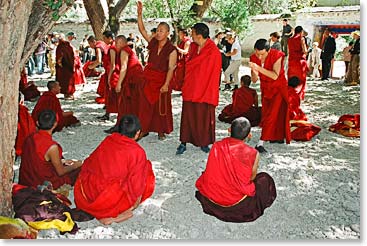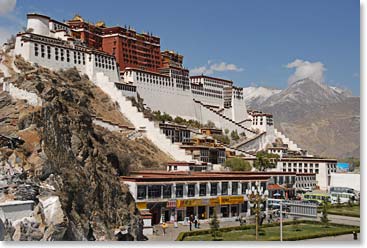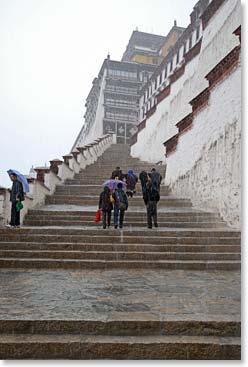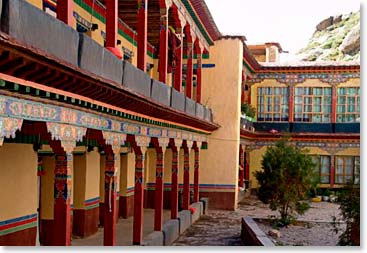
Seven Days in Tibet Expedition Dispatch
November 1, 2012 – 432 steps to the top of the Potala Palace!
Our guide, Mr. Pingtso, is a scholar of Buddhism. Or so it seems. We hear volumes about the history and complexities of everything we see, not necessarily in any chronological order. I would like to say we learn volumes, but it is all too much. We all look attentive. When he says things like, ’I told you this earlier’, we all nod and say things like,’Oh, yes.’ But we might as well look blankly at him.
We are enjoying a heat wave in Lhasa. The mornings are crisp and cool and the afternoons are warm and windless. Gerry continues to take credit for the fabulous weather we have had since we stepped off the plane in Kathmandu and we are starting to believe him.
The Potala Palace is an imposing structure and you can imagine how intimidating it was rising above the plain when there were only mud structures or yurts around it. It is pretty intimidating, now, there are lots of steps. Lots. After our Base Camp trek, we thought we would be in amazing shape and stride up. Instead, we reverted to our trekking mantra, ‘poli, poli.’ Wally and Temba would have been proud. We did learn a thing or two about climbing when we were in the Khumbu.
One of the holiest statues in Tibet is in the Potala Palace. It is not only the former residence of the Dalai Llamas, it is also their tombs, their stupas. And their places of worship. There are many pilgrims and penitents who visit the Palace, not just for the holy relics but also to pray at the stupas. The beautiful murals that cover the wall and the colorful adornment make the residential areas look magical.
We have been trying to figure out just how much gold there is in the Potala Palace. The 5th Dalai Llama has a stupa that is made of 5500 kgs of gold and precious stones. His is the biggest, but they are all gold and all a lot of gold. We had no idea. The more we learn about Buddhism, the less I realize I knew about it. Mr. Pingsto’s teaching is paying off, though and I now recognize the importance of the 5th, 7th, 13th and 14th, and current, Dalai Llamas.

Buddhist monk debating at the Sera Monastery
Buddhist monks debate a lot like Canadian politicians. Lots of noise and thumping. We were at the Sera Monastery. This is another site of great importance to Tibetan Buddhism. Another of the holy statues is here and, again, a lot of pilgrims and penitents. You can place your head inside a stone under the holiest of statues and be blessed by a bhudda. (I am probably not getting this quite correctly) It is also the place where you can bring children to be blessed so there were a lot of babies and toddlers.
The debate is not really a debate at all. About a hundred monks gather in an open area and quiz each other. The monk who is asking the questions slaps his hand and the monk who is making the response has to give the right answer or he gets a back handed slap of the hands. Too many wrong answers and he has to leave. It was interesting. Maroon robes in a sunny, grey stone courtyard under green trees. It was almost like a dance. At one point this monastery had 10,000 monks. Now it has 900.
– By Wendy Kinsella

The Potala Palace – Winter residence of the Dalai Lama until 1959 Tibetan uprising when the 14th Dalai Lama fled to India. The construction started in 1645 by the 5th Dalai Lama.

The Palace covers an area of over 130,000 m2 and stands more than 110 m high; contains 1,000 rooms, 10,000 shrines and about 200,000 statues. It rises 1,000ft. above the valley. There are 432 steps to the top of the Potala Palace.

Sera Monastery - named after a wild rose in the Tibetan language, the hill behind was covered with wild roses in bloom when the monastery was built.

